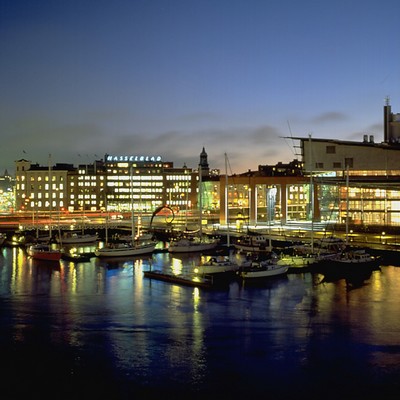Marc Chagall
Les Fables de la Fontaine
Musée Marc Chagall, Nice
14 janvier - 25 mars 1996
En 1926, à la demande du marchand et éditeur Ambroise Vollard, Marc Chagall exécuta une centaine de gouaches pour illustrer les Fables de la Fontaine. Soixante-dix ans plus tard, cette exposition regroupe pour la première fois une partie de cet ensemble extraordinaire : vingt-quatre gouaches auxquelles s’ajoutent quarante gravures réalisées par l’artiste lui-même d’après ses gouaches.
La totalité des gouaches de la série fut exposée à Paris (Galerie Bernheim-Jeune), à Bruxelles (Galerie Le Centaure) puis à Berlin (Galerie Flechtheim) la même année, en 1930. La critique fut pour le moins partagée et certains chroniqueurs s'étonnèrent que l’on ait confié à un artiste étranger l’illustration d’un des chefs-d’oeuvre de la littérature classique française... A l’issue de ces trois expositions, l’ensemble fut dispersé entre plusieurs collectionneurs privés. Aucun musée n’acquit la moindre gouache de la série et les six collections publiques qui en conservent six aujourd’hui les obtinrent plus tard par legs ou donation.
Plus de deux années de recherches ont été nécessaires pour localiser les 43 gouaches reproduites dans le catalogue ; vingt-quatre d’entre elles figurent dans l’exposition, dont neuf qui n’ont pas été vues depuis 1930.
Ces gouaches occupent une place importante dans l’oeuvre de Chagall : dans l’évolution de son art, elles marquent une rupture avec l’imaginaire judéo-russe de son enfance, mais aussi avec l’influence des peintres cubistes rencontrés à Paris au cours du séjour des années 1910-1914, et celle des mouvements constructivistes côtoyés en Russie entre 1914 et 1923. Elles montrent avec quelle fraîcheur et quelle invention l’artiste aborde l’une des oeuvres les plus fameuses de la littérature française ; elles expriment aussi, indirectement, son désir d’intégration dans la culture du pays qui l’accueille.
Sur le plan formel, les gouaches illustrant les Fables de la Fontaine constituent un sommet dans l’art de Chagall. Avec une grande liberté, l’artiste recourt tantôt à des compositions extrêmement simples (comme pour Le Renard et les Raisins ou L’Aigle, la Laie et la Chatte ), tantôt à des mises en scène complexes, à plusieurs personnages et fonds ornementés (comme pour L’Ours et l’Amateur des Jardins, Le Rat et l’Eléphant ou Le Soleil et les Grenouilles).
L’exposition Marc Chagall - les Fables de la Fontaine a d’abord été présentée au Musée d’art moderne de Céret. Le musée Message Biblique Marc Chagall l’accueille en la modifiant un peu le visiteur peut en effet y voir des oeuvres que d’autres illustrateurs ont réalisées pour les Fables de la Fontaine. L’exposition de Nice permet ainsi de mesurer à quel point le travail de Chagall diffère de celui des illustrateurs de La Fontaine qui l’ont précédé l’anthropomorphisme et la primauté des morales sur l’analyse des situations sont deux travers que l’artiste sut éviter, au profit d’une vision poétique qui met en valeur les aspects cocasses, émouvants ou tragiques des récits. On admirera aussi la magnifique utilisation que Chagall fait de la couleur expressive dans ces oeuvres.
Le deuxième volet de l’exposition esquisse l’évolution dans le temps de la perception des Fables à travers la présentation d’oeuvres d’autres illustrateurs ayant travaillé sur différents types de supports assiettes, images d’Epinal, livres, estampes.
En effet, dès le XVIIIème siècle, les Fables deviennent une source d’inspiration majeure pour des artistes comme Chauveau ou Jean-Baptiste Oudry, dont le réalisme animalier triomphe. Au XIXème et au XXème siècles, la vogue des Fables auprès des illustrateurs évolue et donne naissance à des interprétations plus libres. Trois tendances apparaissent :
- la première, représentée par des artistes originaux, propose de nouvelles lectures c’est le cas de Jean-Jacques Grandville, de 1838 à 1845, ou de Gustave Doré, en 1868 ; Chagali s’inscrit aussi, au siècle suivant, dans cette lignée de rénovateurs
- la seconde est celle des satiristes en 1927, Jehan Sennep caricature à travers les personnages des Fables les personnalités politiques de l’époque
- enfin, la troisième témoigne d’un glissement de l’univers de La Fontaine vers l’enfance, glissement qui se produit à la fin du XIXème siècle : les images d’Epinal sont très représentatives de cette évolution.
Publication : Catalogue de l’exposition, préface de Sylvie Forestier, textes de Didier Schulmann, 144 pages, 43 illustrations couleurs, 145F, édition RMN
Cette exposition a été organisée par la Réunion des musées nationaux/Musée National Message Biblique Marc Chagall, à Nice, et la Ville de Céret/Musée d’art moderne de Céret.
Commissaire Didier Schulmann, conservateur au Musée national d’Art moderne, Paris
Musée National Message Biblique Marc Chagall
Avenue Docteur Ménard, 06000 Nice


